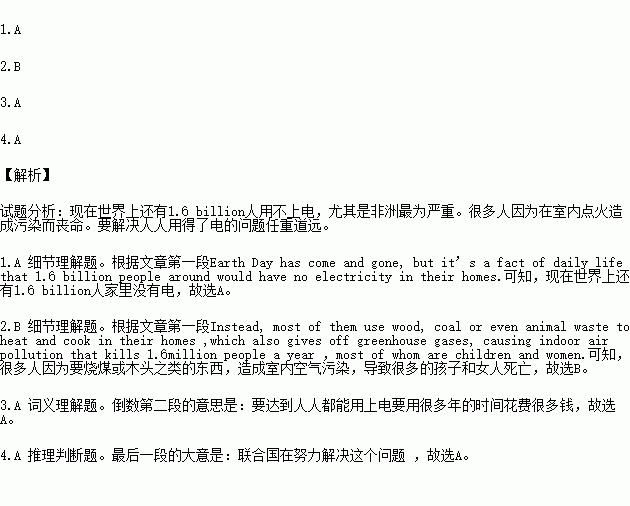题目内容
Earth Day has come and gone, but it’s a fact of daily life that 1.6 billion people around would have no electricity in their homes. Instead, most of them use wood, coal or even animal waste to heat and cook in their homes ,which also gives off greenhouse gases, causing indoor air pollution that kills 1.6million people a year, most of whom are children and women.
It’s not expected to improve much, and in Africa it’s becoming worse now. By 2030, when the Earth’s population will be likely to top 8billion, 1.3 billion people will still lack electricity. Of those, 700 million will be in Africa, and 490 million in South Asia.
Ghana, in West Africa, most of the northern half of the country lives without lights. As a result, three out of four Ghanans in the north are without electricity to refrigerate with and to cook with, to study with and to start businesses with. Like most others around the world in the same situation, these Ghanans use traditional fuels( wood, coal, animal waste) to meet their cooking needs.
What would electricity for everyone around the world cost? The International Energy Agency, which is made up of 28 member countries, figures it would run35 billion dollars a year from 2008 to 2030 to reach that.
The United Nations has been busy with the issue, organizing a meeting on April 28 hosted by Secretary-General Ban Kimoon. ‘ Energy services are very important formeeting basic human needs, reducing poverty, creating and getting together wealth and keeping advances in social development,” He said in an announcement.
1.How many people still lack electricity in the world now?
A. 1.6 billion. B. 1.6 million
C. 1.3 billion D. 700 million
2. Why do many children and women die of indoor air pollution?
A. Because they would rather heat and cook with traditional fuels than with electricity.
B. Because of no electricity they have to use traditional fuels for heating and cooking.
C. Because wood, coal or animal waste does great harm to their health.
D. Because there are too many greenhouse gases from factories.
3.The underlined word “that” probably refer to______.
A. electricity for everyone B. 35 billion dollars a year
C. traditional fuels D. 28 member countries
4.What can we learn from the last paragraph?
A. The United Nations is trying to solve the problem.
B. The basic human needs are reducing poverty.
C. Working together is a way to develop.
D. The basic needs for humans are energy services.

